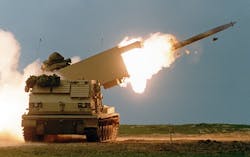Army Precision Strike Missile (PrSM) enters engineering and manufacturing development (EMD), early production
REDSTONE ARSENAL, Ala. – Tactical missile designers at Lockheed Martin Corp. are moving ahead with developing some of the first U.S. Army long-range Precision Strike Missile (PrSM) systems to destroy enemy targets as far away as 300 miles.
Officials of the Army Contracting Command at Redstone Arsenal, Ala., announced a $23.9 million order last Wednesday to the Lockheed Martin Missiles and Fire Control segment in Grand Prairie, Texas, for PrSM full-scale development and early operational capability.
The PrSM, which should enter service in 2023, will be a surface-to-surface, all weather, precision-strike guided missile fired from the M270A1 Multiple Launch Rocket System (MLRS) and the M142 High Mobility Artillery Rocket System (HIMARS).
The order is for engineering and manufacturing development (EMD), and early operational capability of PrSM lot-one missiles that are in milestone B. EMD is the last developmental stage before full-scale production.
The long-range precision-attack PrSM is to replace non-insensitive and cluster munition versions of the Army MGM-140 Army Tactical Missile System (ATACMS).
PrSM will provide Army and Marine Corps field artillery units with long range and deep strike capability. The PrSM will destroy, neutralize, or suppress targets at ranges from 43 to 250 miles using indirect precision fires.
The baseline missiles will be able to engage a wide variety of targets at ranges as long as 310 miles. It will emphasize imprecisely located area and point targets. Primary emphasis for follow-on upgrades will be on increased range, lethality, and ability to attack time-sensitive, moving, hardened, and fleeting targets.
By 2025 the Army will be able to use PrSM to attack and destroy moving enemy ships operating offshore at ranges out to about 310 miles. While the weapon primarily has surface-to-surface applications for use against enemy air defenses, troop fortifications, and armored vehicle columns, the PrSM is being configured with an advanced targeting multi-mode seeker to include maritime strike.
The new targeting seeker has completed a captive carry test wherein it flew aboard an aircraft against representative targets in preparation for further testing and ultimate deployment.
On this order Lockheed Martin will do the work in Grand Prairie, Texas, and should be finished by April 2025. For more information contact Lockheed Martin Missiles and fire control online at www.lockheedmartin.com, or the Army Contracting Command-Redstone at https://acc.army.mil/contractingcenters/acc-rsa.

John Keller | Editor-in-Chief
John Keller is the Editor-in-Chief, Military & Aerospace Electronics Magazine--provides extensive coverage and analysis of enabling electronics and optoelectronic technologies in military, space and commercial aviation applications. John has been a member of the Military & Aerospace Electronics staff since 1989 and chief editor since 1995.

